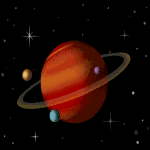Space and Astronomy


|
|
|
|
|
|
|
|
|
|
|
Friday November 1 |
Tuesday Friday November 8 |
Friday November 15 |
Friday November 22 |

The Taurid Meteor Shower peaks on the night of November 11-12. Unfortunately the nearly Full Moon will interfere.
Venus (Mag -4.1) sets in the west at 8:06 p.m. on the 1st. .
Jupiter (Mag -2.8) rises in the east-northeast at 8:17 p.m. on the 1st.
Mars (Mag -0.2) rises in the East at 11:07 p.m. on the 1st.
Saturn (Mag +0.9) sets in the West at 2:48 a.m. on the 1st.
Reprinted with permission, the information above is made available in the Griffith Observer , a monthly publication by the Griffith Observatory. For complete information on the Planets and other items related to Astronomy, please visit the Griffith Observatory Web Site.
The theory that our Sun is the center of the universe and our planets revolve around it was first documented by Nicolas Copernicus. The interesting thing is that Copernicus was a Catholic Priest and Philosopher, not an Astronomer. But he believed that God would have made the movements of the planets more simple than the previously documented theory (which was very complex). As we know today, Corpernicus was right !